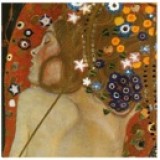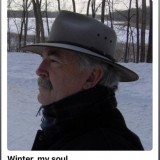Formed poetry
-
Khalid M Darwish
13 years agoHey everyone! Hope all of you have sweet times. So many times I become reluctant whether or not I should post this topic that directly touches poetry. It's related to forms poetry. What I suggest is that there should be a subcategory in this site that explains and provides different forms of poetry available in the web so that every poet would be able to learn what's meant by formed poetry and therefore choose the corresponding form related to his poem. Well this can be provided as an article but you know poets over here rarely and seldomly check the articles in this site. So I hope you discuss this topic and put it under consideration. Of course some members and moderators may have better suggestions and I'll appreciate if they can provide them.
-
Decayed
13 years agoAcrostic Poetry
Acrostic Poetry is where the first letter of each line spells a word, usually using the same
words as in the title.
Example #1:
Heartbreaking
He broke my heart
Every piece, shattered
All I wanted was his love
Real, as he promised
True, as mine for him
But he walked away
Right in the middle of paradise
Every beat of my heart
Aches for his love
Keeping the flame aglow
I will wait by the light
Never losing the hope
God will send him back to me
Copyright © 2000 Jody Kuperavage
-----------------------------------------
Rondeau
A Rondeau is a French form, 15 lines long, consisting of three stanzas: a quintet, a quatrain, and a
sestet with a rhyme scheme as follows: aabba aabR aabbaR. Lines 9 and 15 are short - a
refrain (R) consisting of a phrase taken from line one. The other lines are longer (but all of the
same metrical length).
Example #1:
Springtime Air
Come follow me, I'll lead you where
The days are fine and nights are fair;
Where fields of clover, lush and green,
Will visit you within this scene --
As March inhales the springtime air.
So come with me and we shall share
The freshness springtime can ensnare,
As fields of flowers thus convene.--
Come follow me...
Springtime's approach to which we're heir
Will bring about winter's repair,
Where we shall witness sights serene
And glory in that to be seen.
No other season can compare.
Come follow me...
Copyright © 2004 Dan Tharp
--------------------------------------------------
Quatern
A Quatern is a sixteen line French form composed of four quatrains. It is similar to the Kyrielle
and the Retourne. It has a refrain that is in a different place in each quatrain. The first line of
stanza one is the second line of stanza two, third line of stanza three, and fourth line of stanza
four. A quatern has eight syllables per line. It does not have to be iambic or follow a set rhyme
scheme.
line 1
line 2
line 3
line 4
line 5
line 6 (line 1)
line 7
line 8
line 9
line 10
line 11 (line 1)
line 12
line 13
line 14
line 15
line 16 (line 1)
- Sent in by Crystal Rose.
Example #1:
True Love, Redefined
One day she hopes true love to find,
One soul, one mind, two hearts entwined;
Somewhere out there's the perfect guy,
For Youth has set her standards high.
He must be rich, handsome, refined,
One day she hopes true love to find;
Yet no one seems to measure up
And disappointment fills her cup.
The years go by, her nights grow long,
Her aging voice sings sorrow's song.
One day she hopes true love to find,
Her definition redefined;
Simply a plain and faithful friend
To see her to life's journey's end;
For though her face with age be lined,
One day she hopes true love to find.
Copyright © 2003 Linda Newman
Ode
An Ode is a poem praising and glorifying a person, place or thing.
Example #1:
An Ode To Dreamers
When dreamers dream
And lovers love
Do they receive their visions
From heaven above?
Or do they originate
Where all things start
Within our minds
Within our hearts?
I know not all
But what I do know is this
You cannot build a Kingdom
Upon a flimsy wish
So believe in your dreams
Follow them blind
Lest you loose them all,
To the hands of time.
Copyright © 2000 B. R. Jording
Monody
A monody is a poem in which one person laments another's death, as in Tennyson's
Break, Break, Break, or Wordsworth's She Dwelt Among the Untrodden Ways.
(Also see Dirge, Elegy, Epitaph)
Example:
The Sea's Handmaiden
She often walked along the shore
In windy weather or in fair,
But now my love shall stroll no more,
Nor will the breeze play with her hair.
I did not even know her name
When she came to me that summer day.
A wild thing that I could never tame,
But all the same, I thought she'd stay.
I've lost her, my love, to the sea
Her footsteps fading in the sand.
If only the waves would return her to me,
So we might stroll hand in hand.
Copyright © 2001 Dendrobia
Lanturne
The Lanturne is a five-line verse shaped like a Japanese lantern with a syllabic pattern of one,
two, three, four, one.
Example #1:
Swift
Winds blow
threatening,
a tornado
grows.
Copyright © 2003 Crystal Rose
Ghazal
A Ghazal is a poem that is made up like an odd numbered chain of couplets, where each couplet is
an independent poem. It should be natural to put a comma at the end of the first line. The Ghazal
has a refrain of one to three words that repeat, and an inline rhyme that preceedes the refrain.
Lines 1 and 2, then every second line, has this refrain and inline rhyme, and the last couplet should
refer to the authors pen-name... The rhyming scheme is AA bA cA dA eA etc.
Example:
These Aged Pines
Amid lush fern carpet stand perpending pillars;
Into broad canopy rise impending pillars.
Shady gloom in quiet calm hangs perpetual
Neath enshrouding shelter of attending pillars.
Ringlets firm encircle hearts of antiquity,
Deeply shielded within great suspending pillars.
More than stately; more than magnificently made,
High up into heavens reach transcending pillars.
Among elder giants Zahhar walks astonished,
His heart held uplifted by extending pillars.
Copyright © 2006 Erin Thomas
Epitaph
An epitaph is a brief poem inscribed on a tombstone praising a deceased person, usually
with rhyming lines.
Example #1:
What happened to me, was not good,
Hit by a car, bounced off the hood,
Would get up, if only I could,
Now here I lay, where once I stood.
Copyright © 2001 Lorraine Nisbet
Diamante
A Diamante is a seven-lined contrast poem set up in a diamond shape. The first line begins with a
noun/subject, and second line contains two adjectives that describe the beginning noun. The third line
contains three words ending in -ing relating to the noun/subject. The forth line contains two words that
describe the noun/subject and two that describe the closing synonym/antonym. If using an antonym for
the ending, this is where the shift should occur. In the fifth line are three more -ing words describing
the ending antonym/synonym, and the sixth are two more adjectives describing the ending
antonym/synonym. The last line ends with the first noun's antonym or synonym.
To make it a bit simpler, here is a diagram.
Line 1: Noun or subject
Line 2: Two Adjectives describing the first noun/subject
Line 3: Three -ing words describing the first noun/subject
Line 4: Four words: two about the first noun/subject, two about the antonym/synonym
Line 5: Three -ing words about the antonym/synonym
Line 6: Two adjectives describing the antonym/synonym
Line 7: Antonym/synonym for the subject
Example #1:
Rain
humid, damp
refreshing, dripping, splattering
wet, slippery, cold, slushy
sliding, melting, freezing
frigid, icy
Snow
Copyright © 2000 Marie Summers
Tyburn
A six line poem consisting of 2, 2, 2, 2, 9, 9 syllables.
The first four lines rhyme and are all descriptive words. The last two lines rhyme and incorporate
the first, second, third, and fourth lines as the 5th through 8th syllables.
Example #1:
Death
Blackest
Darkest
Coldest
Oldest
Burning in the Blackest, Darkest night
There in lives the Coldest, Oldest fright
Copyright © 2001 Mike McCann
Terzanelle
The Terzanelle is a poetry type which is a combination of the villanelle and the
terza rima forms. It is a 19-line poem consisting of five interlocking triplets/tercets
plus a concluding quatrain in which the first and third lines of the first triplet appear
as refrains. The middle line of each triplet is repeated, reappearing as the last line
of the succeeding triplet with the exception of the center line of the next-to-the-last
stanza which appears in the quatrain. The rhyme and refrain scheme for the triplets
is as follows:
1. A
2. B
3. A
4. b
5. C
6. B
7. c
8. D
9. C
10. d
11. E
12. D
13. e
14. F
15. E
Ending Type 1:
16. f
17. A
18. F
19. A
Ending Type 2:
16. f
17. F
18. A
19. A
Each line of the poem should be the same metrical length.
Example #1:
A River Flows
A gentle river flows
In the valley below
A gentle river flows
Where blue carnations grow
On the shores of heartache
In the valley below
where loves dreams re-awake
with the passing seasons
on the shores of heartache
no one knows the reasons
loves heart will beat once more
with the passing seasons
on this lone distant shore
where sadness is lifted
loves heart will beat once more
when the spirits shifted
A gentle river flows
where sadness is lifted
A gentle river flows
Copyright © 2003 Crystal Rose
Senryu
Most popular definition, but there is more to senryu than meets the eye:
Senryu (also called human haiku) is an unrhymed Japanese verse consisting of three unrhymed
lines of five, seven, and five syllables (5, 7, 5) or 17 syllables in all. Senryu is usually written in
the present tense and only references to some aspect of human nature or emotions. They possess
no references to the natural world and thus stand out from nature/seasonal haiku.
The 5/7/5 rule was made up for school children to understand and learn this type of poetry.
For an in depth description of Haiku, please visit the Shadow Poetry Haiku, Senryu,
and Tanka section. There is much more to senryu than the madeup 5/7/5 version.
Example #1:
Brilliant words flowing
From those never knowing, how
many lives they touch....
Copyright © 2001 Connie Marcum Wong
Villanelle
A Villanelle is a nineteen-line poem consisting of a very specific rhyming scheme:
aba aba aba aba aba abaa.
The first and the third lines in the first stanza are repeated in alternating order throughout the
poem, and appear together in the last couplet (last two lines).
Example #1:
Runaway
Why do they runaway?
My soul so beautiful, so bright
But for some reason I keep them at bay
Sometimes I wish they would stay
They give up on me without a fight
Why do they runaway?
Some think I am pretty, I say I'm okay
Though this doesn't feel right
But for some reason I keep them at bay
What can I do, what can I say?
What causes their flight?
Why do they runaway?
Just when I think I've won their heart, they stray
I feel like the farthest planet in the night
But for some reason I keep them at bay
What have I done to chase them away?
My soul beckons to them like a beacon of light
Why do they runaway?
But for some reason I keep them at bay
Copyright © 2000 Julie Wright
Sonnet
A Sonnet is a poem consisting of 14 lines (iambic pentameter) with a particular rhyming scheme:
Examples of a rhyming scheme:
#1) abab cdcd efef gg
#2) abba cddc effe gg
#3) abba abba cdcd cd
A Shakespearean (English) sonnet has three quatrains and a couplet, and rhymes abab cdcd efef gg.
An Italian sonnet is composed of an octave, rhyming abbaabba, and a sestet, rhyming
cdecde or cdcdcd, or in some variant pattern, but with no closing couplet.
Usually, English and Italian Sonnets have 10 syllables per line, but Italian Sonnets can also have
11 syllables per line.
French sonnets follow in this same pattern, but normally have 12 syllables per line.
Example #1:
Sonnet of Demeter--Italian Sonnet
Oh the pirate stars, they have no mercy!
Masquerading as hope they tell their lies;
Only the young can hear their lullabies.
But I am barren and I am thirsty
Since she has gone. No hope is there for me.
I will roam and curse this earth and these skies--
Death from life which Zeus sovereign denies.
My heart's ill shall the whole world's illness be
Till she is returned-- my daughter, my blood--
From the dark hand of Hades to my care.
With my tears these mortals shall know a flood
To show Poseidon's realm desert and bare.
No myrtle shall flower, no cypress bud
Till the gods release her...and my despair.
Copyright © 2000 Erica F
Tetractys
Tetractys, a poetic form invented by Ray Stebbing, consists of at least 5 lines of 1, 2, 3, 4, 10
syllables (total of 20). Tetractys can be written with more than one verse, but must follow suit
with an inverted syllable count. Tetractys can also bereversed and written 10, 4, 3, 2, 1.
Double Tetractys: 1, 2, 3, 4, 10, 10, 4, 3, 2, 1
Triple Tetractys: 1, 2, 3, 4, 10, 10, 4, 3, 2, 1, 1, 2, 3, 4, 10
and so on.
"Euclid, the mathematician of classical times, considered the number series 1, 2, 3, 4 to have mystical
significance because its sum is 10, so he dignified it with a name of its own - Tetractys. The tetractys
could be Britain's answer to the haiku. Its challenge is to express a complete thought, profound or
comic, witty or wise, within the narrow compass of twenty syllables." - Ray Stebbing
Example:
freedom
free
from you
your ego
your blaming me
i am a free spirit who has no past
Septolet
The Septolet is a poem consisting of seven lines containing fourteen words with a break in between
the two parts. Both parts deal with the same thought and create a picture.
Example #1:
Untitled
Lion
moving swiftly
across the plain,
most intent.
Antelope
grazing contently
on his meal.
Copyright © 2003 Crystal Rose
Rondel
A French form consisting of 13 lines: two quatrains and a quintet, rhyming as follows:
ABba abAB abbaA. The capital letters are the refrains, or repeats.
Example:
A Rondel for Margarita
On the carousel, on a summer's day,
As the rest of the fairground goes gliding by,
We coast together, now low, now high,
But how quickly the moment slips away.
She laughs at the music, elfin and fey,
She laughs for joy at the sapphire sky,
On the carousel, on a summer's day,
As the rest of the fairground goes gliding by.
How sweet her delight in simple play,
Someday, without me, she'll take to the sky,
Brave little fledgling, ready to fly.
We must hold these moments while we may
On the carousel, on a summer's day.
Copyright © 2004 Gail Kavanagh
Quatrain
A Quatrain is a poem consisting of four lines of verse with a specific rhyming scheme.
A few examples of a quatrain rhyming scheme are as follows:
#1) abab
#2) abba -- envelope rhyme
#3) aabb
#4) aaba, bbcb, ccdc, dddd -- chain rhyme
Example:
Lord of Deceit
Trapped within a haze of fear,
The Lord of Lies does appear.
Clouded by so much that's wrong,
Truth gets twisted by his song.
Turning love and joy to pain,
Hidden by the falling rain.
Tragedy becomes the norm
When hate and fear begin to form.
Hurtful lies tear lives apart
And cause more harm to a heart.
Once the pain and hate begin,
Nothing is the same again.
Once the lie has been revealed,
Secrets are no more concealed.
Then the healing can undo
What he has done unto you.
Once the healing has begun,
Love and happiness have won.
With the truth, you can defeat
The spiteful Lord of Deceit.
Copyright © 2000 Theresa King
Ottava Rima
A Ottava Rima is a poem written in 8-line octives. Each line is of a 10 or 11 syllable count in
the following rhyme:
one octive poem. abababcc
two octive poem. abababcc, dededeff
three octive poem. abababcc, dededeff, ghghghii
...so on and so on
Example:
He is There
When sorrow lies entrenched within your heart
And doubts, like ocean waves, around you churn,
When chaos reigns o'er life and won't depart
And for the peace of yesterday you yearn,
When evil thoughts are tearing you apart
And there is nowhere left for you to turn,
When dark of night persists throughout your day,
It's time to fall upon your knees and pray.
For God is there, He's always by your side,
He is your life's companion and your friend,
He's with you through each bitter storm you ride,
From morn's first light to sunset at day's end.
You must give up your bitterness and pride
And to your Lord extend your hand again.
He only wants for you to ask Him in
And you will be forgiven for your sin.
Copyright © 2003 Linda Newman
Quatrain
A Quatrain is a poem consisting of four lines of verse with a specific rhyming scheme.
A few examples of a quatrain rhyming scheme are as follows:
#1) abab
#2) abba -- envelope rhyme
#3) aabb
#4) aaba, bbcb, ccdc, dddd -- chain rhyme
Example:
Lord of Deceit
Trapped within a haze of fear,
The Lord of Lies does appear.
Clouded by so much that's wrong,
Truth gets twisted by his song.
Turning love and joy to pain,
Hidden by the falling rain.
Tragedy becomes the norm
When hate and fear begin to form.
Hurtful lies tear lives apart
And cause more harm to a heart.
Once the pain and hate begin,
Nothing is the same again.
Once the lie has been revealed,
Secrets are no more concealed.
Then the healing can undo
What he has done unto you.
Once the healing has begun,
Love and happiness have won.
With the truth, you can defeat
The spiteful Lord of Deceit.
Copyright © 2000 Theresa King
Limerick
A Limerick is a rhymed humorous or nonsense poem of five lines which originated in Limerick, Ireland.
The Limerick has a set rhyme scheme of : a-a-b-b-a with a syllable structure of: 9-9-6-6-9.
The rhythm of the poem should go as follows:
Lines 1, 2, 5: weak, weak, STRONG, weak, weak, STRONG, weak, weak, STRONG, weak, weak
Lines 3, 4: weak, weak, STRONG, weak, weak, STRONG, weak, weak
This is the most commonly heard first line of a limerick: "There once was a man from Nantucket."
Example #1:
The Test Pilot
A Plane builder needed a pilot,
So Bob told the guy, he would try it.
When Bob took to the air,
Plane parts fell everywhere.
Bob radioed "where shall I pile it?"
Copyright © 2005 Jim Dupy
Haiku
Most popular definition, but there is more to haiku than meets the eye:
Haiku (also called nature or seasonal haiku) is an unrhymed Japanese verse consisting of three
unrhymed lines of five, seven, and five syllables (5, 7, 5) or 17 syllables in all. Haiku is usually
written in the present tense and focuses on nature (seasons).
The 5/7/5 rule was made up for school children to understand and learn this type of poetry.
For an in depth description of Haiku, please visit the Shadow Poetry Haiku, Senryu, and Tanka
section. There is much more to haiku than the made up 5/7/5 version.
Example #1:
Pink cherry blossoms
Cast shimmering reflections
On seas of Japan
Copyright © Andrea
Etheree
The poetry form, Etheree, consists of 10 lines of 1, 2, 3, 4, 5, 6, 7, 8, 9, 10 syllables. Etheree can
also be reversed and written 10, 9, 8, 7, 6, 5, 4, 3, 2, 1. Get creative and write an Etheree with
more than one verse, but follow suit with an inverted syllable count.
Reversed Etheree: 10, 9, 8, 7, 6, 5, 4, 3, 2, 1
Double Etheree: 1, 2, 3, 4, 5, 6, 7, 8, 9, 10, 10, 9, 8, 7, 5, 4, 3, 2, 1
...Triple Etheree, Quadruple Etheree, and so on!
Example #1:
Your Wild Awakening
Scent
of woods;
callouses
on hands I stroke
speak of hard-spent days.
I trace a stubbled chin
and hear my name unspoken
in a warm unwavering gaze.
Pressing kisses taste of surging need.
I revel in your wild awakening.
Copyright © 2003 Andrea Dietrich
Didactic Poetry
Didactic Poetry is a form of poetry intended for instruction such as for knowledge or to teach.
Example:
Recipe For Heavenly Destination
To get to Heaven
And stay with Christ
Follow this recipe
And his face you will see
Love
Love your neighbor
Love everyman
Spread the love as much as you can
Pray
Talk to the Lord
Show Him you care
With Him your feelings and worries share
Follow
Follow his teachings
Follow his way
Wherever he goes, follow you may
Lead
Lead the ones who don't see
Lead the ones that don't feel the love
Lead them to the Lord above
Copyright © 2000 David Arlaud
Ballad
A short narrative poem with stanzas of two or four lines and usually a refrain. The story of a ballad
can originate from a wide range of subject matter but most frequently deals with folk-lore or popular
legends. They are written in straight-forward verse, seldom with detail, but always with graphic
simplicity and force. Most ballads are suitable for singing and, while sometimes varied in practice,
are generally written in ballad meter, i.e., alternating lines of iambic tetrameter and iambic trimeter,
with the last words of the second and fourth lines rhyming.
Example:
The Ballad of Marian Blacktree
Refrain:
Oh, do you know the mountain road
That leads to yonder peak?
A few will walk that trail alone,
Their dreams they go to seek.
(I)
One such was Marian Blacktree,
A lowly sheperdess,
And courting her was Tom, the swain,
Who loved her nonetheless.
(II)
A thought occurred to Marian
While watching o'er her sheep,
And gazing at the mountain thus
She nodded off to sleep.
(Refrain)
(III)
That night she came to Tom and said
She longed to know the sky.
"I'm weary of this valley, love,
I want to learn to fly!"
(IV)
Poor Thomas did not want to leave,
This valley was all he knew.
So when she turned and left him there
Her heart, it broke in two.
(Refrain)
(V)
Her faithful swain did track her,
All night the trail led on,
And finally at the mountain top
He looked, but she was gone.
(VI)
As morning broke and lit the sky
An eagle he did see:
It circled 'round him thrice and cried.
He knew now she was free.
(Refrain)
Copyright © 2001 Dendrobia
Tongue Twister Poem
A Tongue Twister poem is made up of lines/verses that are hard to say when read aloud
by using similar consonant sounds in succession (use of alliteration). In other words, the
poem ties your tongue into knots. This form does not require end or internal rhyme.
Example #1:
Vino
vile vintage vino
via violent varicose veins
vagrant vapors vacate
vast vascular vessels
vanity vamoose
while visions of
voluptuous vixens
vibrating vigorously
virtually vaporize
into a vast vapid vat
of venomous venules
Copyright © 2001 Lorraine Nisbet
Tanka
Tanka is a classic form of Japanese poetry related to the haiku with five unrhymed lines of five,
seven, five, seven, and seven syllables. (5, 7, 5, 7, 7)
The 5/7/5/7/7 rule is rumored to have been made up for school children to understand and learn
this type of poetry. For an in depth description of Haiku, please visit the Shadow Poetry Haiku,
Senryu, and Tanka section.
Example #1:
A cool wind blows in
With a blanket of silence.
Straining to listen
For those first few drops of rain,
The storm begins in earnest.
Copyright © 2001 Dendrobia
Sestina
The sestina is a strict ordered form of poetry, dating back to twelfth century French troubadours. It
consists of six six-line (sestets) stanzas followed by a three-line envoy. Rather than use a rhyme
scheme, the six ending words of the first stanza are repeated as the ending words of the other five
stanzas in a set pattern. The envoy uses two of the ending words per line, again in a set pattern.
First stanza, ..1 ..2 ..3 ..4 ..5 ..6
Second stanza, ..6 ..1 ..5 .. 2 ..4 ..3
Third stanza, ..3 ..6 ..4 ..1 ..2 ..5
Fourth stanza, ..5 ..3 ..2 ..6 ..1 ..4
Fifth stanza, ..4 ..5 ..1 ..3 ..6 ..2
Sixth stanza, ..2 ..4 ..6 ..5 ..3 ..1
Concluding tercet:
middle of first line ..2, end of first line ..5
middle of second line ..4, end of second line..3
middle if third line ..6, end of third line ..1
Example:
Sestina, to the lover's rite
We stand at last upon this eventide, to give
to each our vow. To the lover's rite abide.
Let that which does not end return,
and let no turning days divide us.
I confess I am afraid of what certain mystery
a seasonless sun reveals.
I fear more the solitary life revealed
in Autumn's long spell. Then let it be this life I give
without caution. And let the mystery
rest untouched where sea and land abide.
My soul recalls no still night felled between us.
It seems we were born together, and together return
anew to the whitening day. To the turn
of the sovereign tide. My hands laid bare reveal
another light. And hand to my hand we make a country of us,
my companion of nightlong ways. Let these common lands give
shape to sleeping wiles. Let the bright and pebbled shore abide
the rushing sea. "In country sleep" we'll toil our songstilled mystery.
And will we sing, in furthered seasons, the hearthstone mysteries
of time's greener passion? Love again our tamer glories? If so return
to the hallowed spire of youth. In this gentle fate we'll abide,
for what is our hymn but a child's bedtime refrain? What is revealed
in mystery but the coming breeze we long to breathe and give
to the new? Its buried scent a memory which knows us
again. Then by the sway of winter's solemn flame let us
firm this vow. Though the prophet moon still steadies her mystery
before us, our last will be a greener gold, given
to the one sacrament. And breath by breath return
again to our certain selves, our nightbound promise revealed.
Heart of this heart abide.
Soul of this soul abide.
We were born together, and together let us
pass unknown through porticos of the half-light shadow, revealing
in turn the break of every lasted dawn, and each unsummoned mystery
inspired on a shifting sea. It is the end days return.
The proffered gift we give.
Abide at last, and forever love, the mystery
of us. Bound by time's lasting measure we'll return,
revealing with every breath our souls to give.
Copyright © 2000 Dave Charlon
Rondelet
The Rondelet is a French form consisting of a single septet with two rhymes and one refrain:
AbAabbA. The capital letters are the refrains, or repeats. The refrain is written in tetra-syllabic
or dimeter and the other lines are twice as long - octasyllabic or tetrameter.
Example #1:
Such Happiness
Such happiness
Has crept up on me without sound,
Such happiness
Has touched my heart with soft caress;
All life's sharp corners have gone round,
Since I've met you, my friend, I've found
Such happiness.
Copyright © 2003 Linda Newman
Quinzaine
The English word quinzaine come from the French word qunize, meaning fifteen. A quinzaine is
an unrhymed verse of fifteen syllables.
These syllables are distributed among three lines so that there are seven syllables in the first line,
five in the second line and three in the third line (7/5/3). The first line makes a statement. The next
two lines ask a question relating to that statement.
Example:
I'm a very strong woman
Are you a woman?
Are you strong?
Copyright © 2003 Katie Schmidt
Palindrome Poetry
Also Known as Mirrored Poetry
A palindrome, by definition, is a word, phrase, verse, sentence, or even poem that reads the same
forward or backward. It stems from the Greek word palindromos: palin, meaning again, and
dromos, meaning a running. Combining the two together, the Greek meaning gives us, running
back again...
Shown below are examples of the word-unit palindrome. The carefully placed words form the same
sentence, whether it is read forward or backward. For example, 'Mirrored images reflect images
mirrored' which includes a word in the center as a reversal point for the sentence or even the poem.
Example #1:
Reflections
Life-
imitates nature,
always moving, traveling continuously.
Falling leaves placed delicately;
foliage touching the echoing waters,
clarity removed -
Reflections distorted through waves rippling;
gracefully dancing
mirrored images
- reflect -
images mirrored.
Dancing gracefully,
rippling waves through distorted reflections -
removed clarity.
Waters echoing the touching foliage;
delicately placed leaves falling -
continuously traveling, moving always,
nature imitates
life.
Copyright © 2002 Lynne C. Fadden
Minute Poetry
The Minute Poem is rhyming verse form consisting of 12 lines of 60 syllables written in strict
iambic meter. The poem is formatted into 3 stanzas of 8,4,4,4; 8,4,4,4; 8,4,4,4 syllables.
The rhyme scheme is as follows: aabb, ccdd, eeff
Example:
I Need Someone
I need someone to hold me tight
Through dark of night,
Who won't go 'way
At break of day.
Someone whose love will mend the seams
Of broken dreams,
And give me back
The trust I lack.
For love, it holds the magic key
To set me free,
To heal my soul
And make me whole.
Copyright © 2003 Linda Newman
Naani
Naani is one of Indian's most popular Telugu poems. Naani means an expression of one and all.
It consists of 4 lines, the total lines consists of 20 to 25 syllables. The poem is not bounded to
a particular subject. Generally it depends upon human relations and current statements. This
poetry was introduced by one of the renowned Telugu poets Dr. N.Gopi, presently working as
vice-chancellor to Telugu University, Andhra Pradesh.
Example #1:
A dialogue
When lengthens
Remain questions
Without answer as criticism.
Copyright © 2001 Bollimuntha venkata Ramana Rao
Kyrielle
A Kyrielle is a French form of rhyming poetry written in quatrains (a stanza consisting of 4 lines),
and each quatrain contains a repeating line or phrase as a refrain (usually appearing as the last
line of each stanza). Each line within the poem consists of only eight syllables. There is no limit
to the amount of stanzas a Kyrielle may have, but three is considered the accepted minimum.
Some popular rhyming schemes for a Kyrielle are: aabB, ccbB, ddbB, with B being the repeated
line, or abaB, cbcB, dbdB.
Mixing up the rhyme scheme is possible for an unusual pattern of: axaZ, bxbZ, cxcZ, dxdZ, etc.
with Z being the repeated line.
The rhyme pattern is completely up to the poet.
Example #1:
My Bouquet
Some days I sing, some days I cry.
My soul's the one determines why.
Sometimes it laughs, sometimes it mourns.
On my bouquet are many thorns.
Wake up each day, face a dark cloud.
My happiness wrapped in a shroud.
The day begins; to me it scorns.
On my bouquet are many thorns.
Lay down my head, dark nights begun.
With the sad setting of the sun.
From all my sorrows my heart mourns.
On my bouquet are many thorns.
Copyright © 2003 Floria Kelderhouse
Fable
A fable is a poetic story composed in verse or prose with a moral summed up at the end. Usually
using animals as characters to teach a valuable lesson.
Most commonly found example of fables are the Aesop's Fables, but here are two poetic examples.
Example #1:
A Grain of Salt
While me irish eyes be smilin`
I be here to tell me story,
Those blyme things that me hates most
not one is in me glory.
Once me was an usher
for a very special settin`
Would not have minded half so much
but it was ME weddin`, that was upsettin`
Me wife insists, and has me wear
those scratchy three piece suits,
If truth be known, me`d rather own
green pants, green hat and boots.
Around me neck a noose of sorts
a tie from me graduation,
Me feels like someone`s got me throat
the fear of strangulation.
Oh judge me not, don`t take me wrong
me wife, me loves most sweetly,
When I get back from work at night
the home is picked up neatly.
She pulls me shoes off when I ask
and helps me light me pipe,
She brings in Shamrock blooms each day
so me really shouldn`t gripe.
It matters not the little things
that push us up the wall,
If one has patience, love and trust
may the flaws we bare be small.
To ease the creases from thy brow
put aside each nagging fault,
And heed this moral to the end
take only with a grain of salt.
Copyright © 2003 Sally Ann Roberts
Epic
An Epic is a long narrative poem celebrating the adventures and achievements of a hero...epics
deal with the traditions, mythical or historical, of a nation.
examples: Beowulf, The Iliad and the Odyssey, and Aeneid
Cinquain
Cinquain is a short, usually unrhymed poem consisting of twenty-two syllables distributed
as 2, 4, 6, 8, 2, in five lines. It was developed by the Imagist poet, Adelaide Crapsey.
(For further information, please scroll down for an article on Cinquain from the SP Quill
Quarterly Magazine written by Deborah P Kolodji.)
Another form, sometimes used by school teachers to teach grammar, is as follows:
Line 1: Noun
Line 2: Description of Noun
Line 3: Action
Line 4: Feeling or Effect
Line 5: Synonym of the initial noun.
Example:
angels
kind beyond words
they protect and forgive
and make feelings of blissfulness
cherubim
Copyright © 2003 Erin Holbrook
Triolet
A Triolet is a poetic form consisting of only 8 lines. Within a Triolet, the 1st, 4th, and 7th lines
repeat, and the 2nd and 8th lines do as well. The rhyme scheme is simple: ABaAabAB, capital
letters representing the repeated lines.
Make writing a Triolet more challenging! Make each line 8 syllables in length (4 metrical feet),
written in iambic tetrameter (the more common way), or try it in pentameter (English version)
where each line only has 10 syllables(5 metrical feet).
Example #1:
My Heart Residing in Thy Chest
In response to Shelly's, "The Indian Serenade".
For, break it shall and so it must
My heart residing in thy chest
When placed in care of lover's trust
For, break it shall and so it must
Passion's ashes returned to dust
This lonely heart is laid to rest
For, break it shall and so it must
My heart residing in thy chest
Copyright © 2003 Dan Tharp
Terza Rima
A Terza Rima is a poem with an eleven syllable count in each line and a rhyming scheme
of aba, bcb, cdc, dd.
For even more of a challenge, try the Terza Rima Sonnet. This form of poem has an
eleven syllable count in each line and a rhyming scheme of aba, bcb, cdc, ded, ee.
Example (Terza Rima Sonnet):
Faith
Faith is the glue that holds our lives together,
Faith gives us roots that we may withstand trials
Through dark of night and wind and stormy weather.
Faith comes into our lives and sin beguiles,
Giving us strength to overcome temptation,
To glory over Satan and his wiles.
A firm belief will overpow'r frustration
When life hands us more pain than we can handle,
And, at the end, faith will be our salvation.
So live your life in faith bright as a candle,
Oh let it glow, its flicker not abating,
And let there be no hint of sin or scandal.
For He who died for us in Heaven is waiting
With open arms, in faith, no hesitating.
Copyright © 2003 Linda Newman
Shape Poetry
-Shape Poetry is also associated with Concrete Poetry-
Shape is one of the main things that separate prose and poetry. Poetry can take on many formats,
but one of the most inventive forms is for the poem to take on the shape of its subject. Therefore,
if the subject of your poem were of a flower, then the poem would be shaped like a flower. If it
were of a fish, then the poem would take on the shape of a fish. ><<<*>
Shape and Concrete Poetry go hand-in-hand; however, Concrete or Visual Poetry don't have to
take on the particular shape of the poem's subject, but rather the wording in the poem can enhance
the effect of the words such as in this line:
an angel tumbling
d
o
w
n
to earth . . .
Designing your own shape poem can be simple and fun, but try not to pick anything that would be
too difficult. We suggest mapping out or drawing your shape first, and then importing the text of
your poem into your shape.
Example #1:
Birth of a Triangle
mama and papa and baby make three,
reaching sides of a three-sided tree.
oedipal winds rustle from leaves;
triangular shapes converting
dissimilarity into peeves.
straight lines connect
the corners turned;
mirrored sight
un-burned;
buried
am
i
Copyright © 2001 Alex Goldenberg
Sedoka
The Sedoka is an unrhymed poem made up of two three-line katauta with the following
syllable counts: 5/7/7, 5/7/7. A Sedoka, pair of katauta as a single poem, may address the
same subject from differing perspectives.
Katauta is an unrhymed three-line poem the following syllable counts: 5/7/7.
Example #1:
War Path
Fractured wanderer
leaving a tortured city,
hammocked insecurely.
Quenched of thirst for blood,
he may now respect beauty,
unappreciated 'fore.
Copyright © 2003 Christian Ugalde
Rispetto
A Rispetto, an Italian form of poetry, is a complete poem of two rhyme quatrains with strict meter.
The meter is usually iambic tetrameter with a rhyme scheme of abab ccdd. A Heroic Rispetto is
written in Iambic pentameter, usually featuring the same rhyme scheme.
Example #1:
Tribute to Tuscany
In old Tuscany, this form of poetry
To stimulate the imagination's muse,
Has been passed down through every century,
To all writers whom the written words enthuse.
Even yet today, some vineyard covered hill,
Hung with clustered grapes, romantic souls instill
With a deep desire to try their hand once more
And resurrect a page from history's lore!
Copyright © 2006 Betty Lou Hebert
Pantoum
The pantoum consists of a series of quatrains rhyming ABAB in which the second and fourth lines
of a quatrain recur as the first and third lines in the succeeding quatrain; each quatrain introduces a
new second rhyme as BCBC, CDCD. The first line of the series recurs as the last line of the closing
quatrain, and third line of the poem recurs as the second line of the closing quatrain, rhyming ZAZA.
The design is simple:
Line 1
Line 2
Line 3
Line 4
Line 5 (repeat of line 2)
Line 6
Line 7 (repeat of line 4)
Line 8
Continue with as many stanzas as you wish, but the ending stanzathen repeats the second and
fourth lines of the previous stanza (as its first and third lines), and also repeats the third line of
the first stanza, as its second line, and the first line of the first stanza as its fourth. So the first
line of the poem is also the last.
Last stanza:
Line 2 of previous stanza
Line 3 of first stanza
Line 4 of previous stanza
Line 1 of first stanza
Example #1:
It All Started With A Packet of Seeds
It all started with a packet of seeds,
To be planted with tenderness and care,
At the base of an Oak, free from all weeds.
They will produce such beauty and flare.
To be planted with tenderness and care,
A cacophony of colorful flowers,
They will produce such beauty and flare.
With an aroma that can continue for hours.
A cacophony of colorful flowers,
Bright oranges with yellows and reds,
With an aroma that can continue for hours,
Delivered from their fresh flower beds.
Bright oranges with yellows and reds,
At the base of an oak, free from all weeds,
Delivered from their fresh flower beds,
At all started with a packet of seeds.
Copyright © 2001 Sally Ann Roberts
Nonet
A nonet has nine lines. The first line has nine syllables, the second line eight syllables, the third line
seven syllables, etc... until line nine that finishes withone syllable. It can be on any subject and
rhyming is optional.
line 1 - 9 syllables
line 2 - 8 syllables
line 3 - 7 syllables
line 4 - 6 syllables
line 5 - 5 syllables
line 6 - 4 syllables
line 7 - 3 syllables
line 8 - 2 syllables
line 9 - 1 syllable
Example:
a pirates playground
the ocean is a pirate's playground
they live their lives upon the sea
battles are fought to the death
the loot is divided
they drink to those lost
set sail again
a pirate's
life for
me
Copyright © 2003 Mark Williams
Mirrored Refrain
The Mirrored Refrain is rhyming verse form constructed by Stephanie Repnyek.
The poem is formed by three or more quatrains where two lines within the quatrain
are the "mirrored refrain" or alternating refrain.
The rhyme scheme is as follows: xaBA, xbAB, xaBA, xbAB, etc..
x represents the only lines that do not rhyme within the poem. A and B represent
the refrain. The first four stanzas of the example poem are labeled for better
understanding.
Example:
Child of His Earth
Spirits moving passionately (x)
Soaring with the wind... (a)
I am a child of the Earth, (B)
From the beginning to the end. (A)
God paints his canvas around me (x)
I come alive...a new rebirth (b)
From the beginning to the end (A)
I am a child of the Earth. (B)
Teardrops fall while giving thanks (x)
I hear the voices of the wind (a)
I am a child of the Earth, (B)
From the beginning to the end. (A)
When I'm lonely and blue... (x)
His touch shows me my worth (b)
From the beginning to the end, (A)
I am a child of the Earth. (B)
My sorrows are replaced with happiness
A touch of love is what He gives
I am a child of the Earth,
From the beginning to the end.
I thank Him for the blessings he sends
In my life, He is always first
From the beginning to the end,
I am a child of the Earth.
Appreciating all that surrounds me
I give thanks to God...it's all for him
I am a child of the Earth,
From the beginning to the end.
His breath of wind eases my fear
He makes me strong when times are tough
From the beginning to the end,
I am a child of the Earth.
Spirits moving passionately
Soaring with the wind...
I am a child of the Earth,
From the beginning to the end.
The world may crumble and fall
But my spirit will live through His love
From the beginning to the end,
I am a child of the Earth.
I want to be remembered for my spirit
It's all for God...he made me who I am
I am a child of His Earth,
From the beginning to the end.
Copyright © 2003 Stephanie Repnyek
Kyrielle Sonnet
A Kyrielle Sonnet consists of 14 lines (three rhyming quatrain stanzas and a non-rhyming couplet).
Just like the traditional Kyrielle poem, the Kyrielle Sonnet also has a repeating line or phrase as a
refrain (usually appearing as the last line of each stanza). Each line within the Kyrielle Sonnet
consists of only eight syllables. French poetry forms have a tendency to link back to the beginning
of the poem, so common practice is to use the first and last line of the first quatrain as the ending
couplet. This would also re-enforce the refrain within the poem. Therefore, a good rhyming scheme
for a Kyrielle Sonnet would be:
AabB, ccbB, ddbB, AB -or- AbaB, cbcB, dbdB, AB.
Example:
Make Believe
In a realm some call Make Believe,
they promised they would never leave.
Where crystal blue waters still flow,
Fairies dance beyond the rainbow.
Elves and Unicorns join along
with magical refrains of song.
Through fresh morning dew - all aglow,
Fairies dance beyond the rainbow.
Where Spring is, always, in the air,
iridescent wings - flutter there.
Playfully, putting on a show,
Fairies dance beyond the rainbow.
In a realm some call Make Believe,
Fairies dance beyond the rainbow.
Copyright © 2003 James Dean Chase
Free Verse
Free Verse is an irregular form of poetry in which the content free of traditional rules of versification,
(freedom from fixed meter or rhyme).
In moving from line to line, the poet's main consideration is where to insert line breaks. Some ways
of doing this include breaking the line where there is a natural pause or at a point of suspense for the
reader.
Following the direction of Walt Whitman, Ezra Pound and T.S.Eliot, many modern day poets use
this particular form of expression.
Example:
Ode to Job
Job came down
in a
woosh, outstretched
and gliding into the horizon.
Blue shadowed
flight
arrested by
the beckoning marsh.
His greatness bears
much
yet not
the anguish of ancient
prophecy.
Situated grievances weigh
feathery
on this long,
strong back. Unconscious
emotion
numbs while
time drifts out
another
sun salted
day.
Copyright © 2001 Lachlan Ivy
Epigram
Epigrams are short satirical poems ending with either a humorous retort or a stinging punchline.
Used mainly as expressions of social criticism or political satire, the most common forms are
written as a couplet: a pair of rhymed lines in the same meter.
Practioners of this poetic expression include John Dunne, Ben Jonson, William Blake and
Robert Frost.
Example:
Bent and battered, the live oaks have through ages survived
until developed senses of modern man ripped them up still alive.
Time rolls out down wide grassy lawns
yet within these suburbs a dearth of it is spawned.
Such volunteers are said to advocate
but to the law, they instead frustrate.
Copyright © 2001 Lachlan Ivy
Clerihew
A Clerihew is a comic verse consisting of two couplets and a specific rhyming scheme,
aabb invented by Edmund Clerihew Bentley (1875-1956) at the age of 16. The poem
is about/deals with a person/character within the first rhyme. In most cases, the first
line names a person, and the second line ends with something that rhymes with the name
of the person.
One of the most remembered Clerihew from Bentley's collection is:
Sir Humphrey Davy
Abominated gravy.
He lived in the odium
Of having discovered sodium. -
Yakari Gabriel
13 years agoWell... I rather wear crocs than try formed poetry
-
Khalid M Darwish
13 years agoThank you Kevin, Leb. Ph. and Yaki. I wish if you read again my post. What I suggested is providing the poetry forms to be one of the subcategories such as priv. messages, club discussion, favorite authors etc. and not as an article or a normal post. Any member who needs to know, say the cinquain form as an example, should not go to other members' posts to search for it but rather to a subcategory giving this form. You know, our site is even lacking a syllable and word counters as well as a dictionary. It seems that what's introduced by poets is a routine work i.e. post a poem and wait for comments and mayby nomination etc etc. Don't you agree that this seems boring simply because there's nothing new. Our website should undergo renewing the old dresses every year with the help of comparatively old members like you three. I can see that there are somethings new in this site, example when you go to the your favorite authors list you'll find at the same page a new subdivision providing the authors who chose you in their favorite lists (and there's written the word 'new' in red). From that example I concluded that it's possible to have this advantage in adding other things like those which I just proposed. I wonder if the moderators and managers as well can work for that.
-
-
Hellon
13 years agoKalid...formed poetry is an art and sadly...it's never been recognised on this site for some reason...Even afer Larry and I held a contest for different forms it died a death soon after. It's harder to write obviously....A lot of the forms mentioned I have tried and they were posted on an old account I had ....I have developed a form of my own, as have some other members on this site and you can view them on shadowpoetry.com
The fashion here at the mo ment seems to me....like a translation from something you would write in your diary and...that's not poetry in my opinion...
I said, felt..he did..I cried all night as a result...get the drift
Not poetry..just random thoughts and...not even edited out so yeah...I think there is a need for something here and your post is interesting to me but...I honestly don't know where to go from here??? -
Kevin
13 years agoThe thing I dislike about formed poetry is that it constrains me in my natural style and flow. I get the importance of understanding syllable counts and having balance and structure to writing I just tend to write what I consider to be superior poems when I can make up my own structure.
-
ddavidd
13 years agoI could appreciate how musical structures and rhythmical schemes could be beneficial in conveying the burst of an emotional content
but I do not believe in accessories to hide empty thoughts and the lack of emotional intent.
things to hide or to put make up on common writhing.
things such as " Acrostic Poetry " that are mostly like cross words puzzles and games rather than art,
in my humble opinion -
ddavidd
13 years agoContents instead of containers!!
-
Hellon
13 years agoRm..you said somewhere in the past...I can't remember you words now but something along the lines of.....poetry finds you and...I am a very true believer in that..but when you try to write formed poetry your mind contracts then expands and...you will find you can do it...I never thought about controlled poetry before but...I know I can write it if required....
-
ddavidd
13 years agoLong time ago I wrote something in this site about how poetry declared its independence y to music in nineteen and twenty centuries. They both came form the same source: working in group. There is a fine book about the sociology of art ( I am not sure is translated to English) shows how man came across art. It is quite interesting.
Because of emotional content , poetry always was dominated by the music until recently. But it doesn't need to. Poetry is different and even more emotional, and its dependency to sounds could be separated from the musical scheme. it could be totally internal. -
Darren
13 years agoI consider myself fairly able when it comes to writing formed poetry . however it can be restrictive hence why i enjoy mashing forms together. but if you look at the poems posted i am afraid that a vast majority of the users on here. see formed poetry as painting by numbers.
i could turn just about any free forming long winded poem (including most of my own) into a senryu or chained senryu without losing the poems message. -
Khalid M Darwish
13 years agoKevin you say it constrains you in your natural style and flow. You are right but there's a question "why do we study forms of poetry in colleges?" I'm sure that forms of poetry do make the pillars and foundations for poetry, otherwise everyone can throw his thoughts in whatever-way in the name of poetry just to get credits. Of course these thought might be so deep in their meaning but at the same time can't follow any form of poetry (not even the free verse style). I'm sure (100 per cent) if a poet follows at least one form he/she will be an expert after a while. Ancient poets (centuries ago) used to tell few lines at once because they used to deal with poetry in all their life fields.
Real Meaning: Of course most pf the musical lyrics and songs do depend on poetry. -
ddavidd
13 years agoThat too
-
Kevin
13 years ago"why do we study forms of poetry in colleges?"
For the same reason someone studying to become a Doctor has to look at illnesses and conditions they will probably never encounter in their daily practice.
Just in case, and also because if you want to say you are a professionally qualified physician you must have looked at the whole picture.
I studied poetry in college, and it was fun to look at famous and not so famous authors and play around with their forms etc etc, but that doesn't mean formed poetry makes me a better writer, or more importantly if I had a strong feeling or idea for a poem it would be better served and contained inside a structured piece.
Everyone has their own flow, like their own voice and fingerprint. Some people stick to classic forms and ways of doing things so they never learn to write in their own way. I see this constantly with music. Same old chord changes, same old melody progressions.
/yawn -
Decayed
13 years agoI find free English poetry more interesting than formed English poetry.
On the other hand,
I find Arabian formed poetry more interesting than the free one.
-----
I am against the idea of poetry being a science. And with science I mean numbers. Formed poetry makes you think of restrictions and syllables, etc.... I do believe that poetry is pure emotions. I do not need to think of how I should shape my piece. It's just an artistic expression that doesn't need to be engineered. -
Khalid M Darwish
13 years agoOK guys, it seems you all like the free poetry. Well I'm not against you but rather trying to relive something comparatively ignored, the formed poetry. I really went across many websites and found them having subdivisions for it in addition to syllable and word counters as well as dictionary. It's your opinions as well not to have them here. Thank you for sharing.
-
sibyllene
13 years agoI'm also a person who prefers free verse.
But that doesn't mean that my poems don't have structure. There aren't rhyming or syllable rules, but I still have patterns and internal references, I still play with sounds and visual effect. Those are also aspects of poetry. It's more than just "writing a diary entry." -
Larry Chamberlin
13 years agoFor myself I tend to encapsulate my intuitive bursts into short messages easily adapted to senryu. On the other hand free verse occurs just as often and I do not want to constrain the flow. However, I frequently sit with the purpose of doing a specific form. At these times I feel far more in touch with my subject. In attempting to capture the essence of the thing I discover more about myself than expected. Syllable count is so second nature to me I do it unconsciously.
I'd never dream of insisting someone else write in a form they do not want. But I'd invite anyone.
EDIT: The somewhat random thought occurs to me that I use different aspects of personality in my writing:
Senryu == Intuition
Free verse == Emotions
Formed == Thinking
Hmmm









